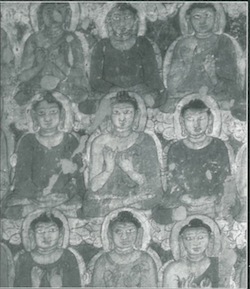India in the sixth century B.C.E. was especially alive with religious adepts going about their business alone or in the company of others. But monastic institutions as we know them, did not exist then, nor did monasteries exist in Buddhism during the Buddha’s lifetime. The pre-Buddhist ideal of the world-renouncing mendicant is already acknowledged in the legend of the “four-signs” which leads to Prince Siddhartha’s renunciation: after seeing examples of old age, sickness, and death, the Buddha-to-be sees a self-composed, serene, and alert “bhikku.” The ideal of this nomadic, world-renouncing lifestyle was well established in Vedic period prior to Buddhism. The Brihadaranyaka Upanishad reads: “He who passes beyond hunger and thirst, beyond suffering and ignorance, beyond old age and death—men, knowing Brahman thus, give up the desire for sons, wealth and prosperity and become bhikkus.” It was this ideal that inspired Siddhartha and led him to experiment with various forms of asceticism: yoga, celibacy, fasting, wandering, begging, and other austerities.

While the ascetic impulse has led adepts of all stripes to “renounce the world,” India seems to have gone further than other cultures in its broad social integration and ritualization of the world-renouncing ideal, a “going-forth” from the life of the householder to that of a nomadic ascetic. A standard Buddhist phrase expresses this transition as a passage from “home into homelessness.”
During the period of the Buddha’s lifetime it was not uncommon for Indian ascetic movements to form communities of hermits and renunciants. The forms of early Buddhist monasticism played a special role in influencing the development of these communities and the movement from an entirely nomadic life to a more settled existence: homelessness into home.
The early followers of the Buddha, the “bhikku-sangha,” embraced the wandering life of the ascetic, but according to the Mahavagga (Vinaya 1.137) the “sons of the Shakyans” were criticized by outsiders because they maintained their nomadic ways through the monsoon season, apparently trampling young plants that had sprung up from the new rains and destroying “small living creatures.” The text paraphrases the critics: “Those who belong to other schools may not be very well-disciplined, but at least they withdraw somewhere to make a residence for the rainy season . . . but these ascetics, the sons of the Shakyans, don’t stop traveling during the summer, winter, and rainy season as well.”
According to the story, the complaints were reported to the Buddha and in response he instituted the rule that monks should maintain a retreat during the rainy season. The mandatory three-month retreats were normally spent in one place, usually in temporary structures, sometimes in boats, and almost always near a town. When the monks abandoned these temporary structures after the rainy season retreats, the structures were left to the elements, vandals, and thieves, suffering the fate of most empty and unattended buildings.
During the Buddha’s lifetime the nomadic monks gained the respect and patronage of wealthy merchants and bankers who donated parks and land. These well-to-do lay followers received further permission from the Buddha to have buildings erected for the ordained sangha. According to Theravadin accounts, there were perhaps twenty-nine significant residences “owned” by the sangha during the Buddha’s lifetime.
But the Buddha and his disciples continued to practice a nomadic life, wandering now from Buddhist home to Buddhist home. No doubt these dwellings made the wandering life easier: arriving at any time of day or night, the monks knew they would be welcome guests; and one can surmise that during the three months of retreat the buildings must certainly have been full. Buddhist bhikkus began to be distinguished from other sects of wanderers as the custom developed of returning to the same “monastery” each rainy season. As the practice of a collective life began to take hold and monasteries came to be further distinguished by the groups who habitually gathered together in that location, the nomadic paradigm continued to recede.
Within a few generations following the Buddha’s death, monasteries clearly emerged as colonies of monks, settled and sedentary, functioning as a corporate body no longer open to anyone and everyone. Perhaps this was inevitable, but the Buddha’s original vision of one universal sangha, which he expressed as a “Sangha of the Four Quarters,” was transformed within a hundred years into separate sanghas which were identified with particular monasteries. This is the point of origin that eventually led to the “schools of thought,” and the sectarianism and schism that we are familiar with today.
Songs of the Elders
from the Buddha’s first disciples
SUMANGALA’S MOTHER
I’m free
Free from kitchen drudgery
No longer a slave among my dirty cooking pots
(My pot smelled like an old water snake)
& I’m through with my brutal husband
& his boring sunshades
I purge lust with a sizzling sound—POP
“O happiness,” meditate upon
this as happiness

MUTTA SPEAKS
Get free, Mutta
free as the moon
free from Rahu the Dragon’s claws
mind free, free of debt
heart free
enjoy the food they give you
when you’re out begging
KOTTITHA
Dead to the world and its troubles
he recites mantras
mind unruffled
shaking distractions away
like the wind-god
scatters a few
forest leaves
Poems from The Quenching of the Lamp: Versions from the Therigatha and Theragatha. Translated by Anne Waldman and Andrew Schelling, published by Rodent Press, Boulder, 1994.
Thank you for subscribing to Tricycle! As a nonprofit, we depend on readers like you to keep Buddhist teachings and practices widely available.